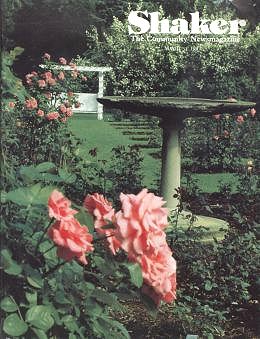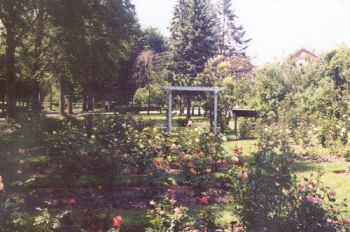|
The garden's 83 year history is one of growth, decline and revitalization.
In 1924 rose-lovers Frederick E. Bruce and William H. Kinsey led a
campaign to raise funds for a Shaker Heights Community Rose Garden. In
1926 Charles
Schneider, the architect of Shaker's City Hall, designed the garden, next
to Woodbury and Onaway schools.
Because the rose garden was on school land, the
school district's staff maintained it. But in the '70s and '80s, as a
consequence of tighter budgets and higher labor
costs, the garden received less care. By the
early '90's it had declined so much that there was consideration of
using the land for a parking lot. The thought of losing the garden stirred
the Onaway School neighborhood. In 1993 former Woodbury Road resident
Lowell Van Deusen made a gift to the Onaway Community Association to help
renew the garden.
The rebirth of the garden
is the story of five years of dedicated volunteer effort and the
cooperation of the schools and the city. About 20 citizens gave their time and skills to
organize, plan and promote the garden. Most of them, along with
perhaps 80 others identified, moved, planted, labeled, mulched, pruned,
weeded, watered and fed the roses.
Gifts from more than 200 donors paid for hundreds of new roses, benches
and an information display.
By 1998 the work of these caring citizens,
public support and the help of the Shaker Schools had brought the Shaker Heights
Community Rose Garden back to life.
|
|
About 1,000 rose bushes,
from old Damask Roses to modern ever-blooming floribunda and Hybrid Tea
roses are planted in the garden. The original plan, as described in a 1927
gardening magazine: "... includes climbing roses on the fence, polyantha
along the street line, rose rugosa in the hedge, sweetbriers at the ends
of the garden and a mixed planting of rose Hugonis, deciduous shrubs and
evergreens, Hybrid teas and hybrid perpetuals fill the beds."
The hybrid roses are organized by color and
type in more than 30 beds —
deep red roses in the southern-most beds, pink in the center beds, yellow
and white at the northern end. Most roses are labeled. An
information panel at the north end of the garden (just right of the
trellis in the above photo) has a map of the garden and a list of donors
and supporters. Most
roses in the garden were planted after 1993, but there are many
pre-1993 specimens
— and
even a few believed to be from the original 1926 - 27 planting.
|
|
Located on land owned by the Shaker
Heights Schools, the garden is next to Woodbury School (5-6th grade) and
near Onaway Elementary School. It is on the east side of Woodbury Road,
about 200 yards south of South Woodland Road. For a map,
click here.
It may be visited at no charge during daylight hours any day of the week.
Most of the roses in the garden are modern ever-blooming varieties and
return to bloom a few times during the summer. Because many of our other
specimens, including dozens of old climbing rose bushes, bloom
only once each year, the summer's first bloom
— perhaps
in early June — is
the garden's most glorious time.
On the cover of the May-June
1997 issue
of Shaker The Community Newsmagazine |
 |
|
The garden is described above at the peak of its rejuvenation.
But in recent years the
plan for the Rose Garden has not been achievable. First, as any rose
gardener will tell you, roses need care. A garden with 1,000 bushes is a
labor-intensive effort that needs many more volunteers than can be found
in these busy times. Second, the garden leaders respected the changed
public attitudes to spraying programs - seen as placing children and
pets at risk - so near our schools. But ending this protection left the
roses vulnerable to disease and a great many bushes have been lost.
Now a transformation of
the garden is being planned. To learn more and to have an opportunity to
express your views, click here.
June 6, 2007 |

